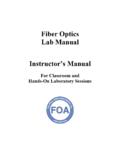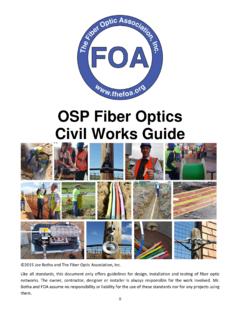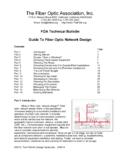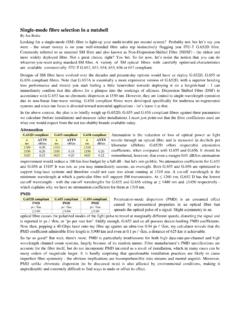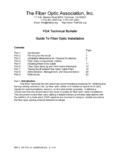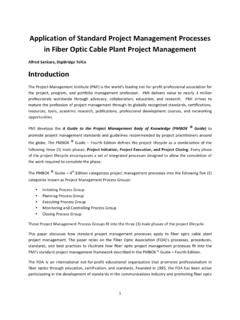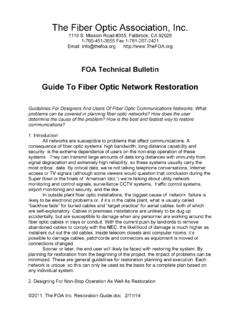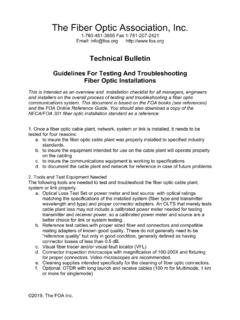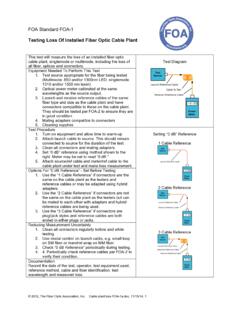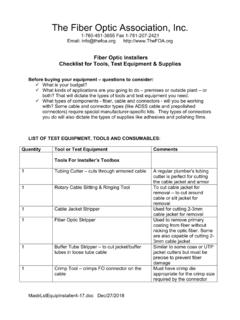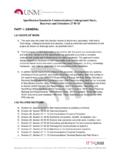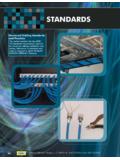Transcription of Uncle Ted's Guide To Communications Cabling
1 2016 The Fiber Optic Association Inc. Uncle Ted's Guide To Communications Cabling Contents Jargon Overview of Structured Cabling Cables Terminations Installation Testing Wrapup, Training Programs and Equipment The Fiber Optic Association Inc. 1119 S Mission Rd #355 Fallbrook, CA 92028 Welcome to Uncle Ted's Guide to voice/data/video Cabling , the printable version of the Uncle Ted s Guide on the web @ Uncle Ted was the mascot of Cable U's training programs about wiring, focusing on Cat 3/5/5e/6/6A UTP Cabling . He's Lennie Lightwave's Uncle and the expert on premises wiring. Uncle Ted's Guide is an overview of what you need to know to get started in installing premises Cabling , voice/data/video Cabling , low voltage or Communications wiring, structured Cabling or whatever you call it. (Turns out the terminology is not standard, perhaps the only thing that isn't!)
2 After reading Uncle Ted's Guide , you might be interested in the FOA textbooks, The FOA Reference Guide to Premises Cabling and The FOA Online Reference Guide with its section on Premises Cabling . Also, check out FOA's free online training site Fiber U where there is a free online self-study program on premises Cabling as well as many other topics on Cabling . And be sure to let us know how you like this Guide and how we can improve it in the future . Email us at Uncle Ted's Guide is also available as a free eBook on iTunes. If you like Uncle Ted's Guide you'll love Lennie Lightwave's Guide To Fiber Optics! Uncle Ted s Guide To VDV Cabling 2016 The Fiber Optic Association Inc. Uncle Ted's Guide To Communications Cabling 2 Cabling Jargon It helps to know the language so here's an overview of the basic jargon used in Cabling and we'll explain more as we go along. To begin with, what do we call this whole area of Cabling ?
3 People call it lots of things: VDV (for voice/data/video), data/voice, low voltage, limited energy, teledata, datacom, premises Cabling , but most call it "structured Cabling " after the "TIA 568" standard. It's the infrastructure for telephone and LAN connections in most commercial installations and even in some modern homes. It's also used for fire alarms, building management, audio and video. Structured Cabling : An architecture for Communications Cabling specified by the EIA/TIA TR42 committee and used as a voluntary standard by manufacturers to insure interoperability. Standards Structured Cabling is based on a number of industry standards - voluntary standards - developed by manufacturers who want their products to interoperate - work together. They meet in committees several times a year and decide on the specifications of their products. These common specs mean that equipment will work on any Cabling system that follows the standards and most Cabling components can be interchanged without adversely affecting performance.
4 Standards Groups: EIA/TIA: Electronics Industry Alliance/Telecommunications Industry Assn, an industry trade association that creates voluntary interoperability standards for the products made by member companies. ISO/IEC: International Standards Organization/International Electrotechnical Commission. EIA/TIA 568: The main standard document for structured Cabling , usually referred to as simply "568." It is now on the "C" revision which includes sections for general specifications and individual sections for copper and fiber optics. Internationally, its equivalent is ISO/IEC 11801. EIA/TIA 569: Covers pathways and spaces. Defines the "telecom closet" or telecom room as it is now called. ISO/IEC 14763-2. EIA/TIA 570: For residential Cabling . EIA/TIA 606: Cabling system administration (documentation), ISO/IEC 14763-1 EIA/TIA 607: Grounding and bonding International Standards The international equivalent of EIA/TIA 568 is ISO/IEC 11801.
5 The standards are written similarly to what has been done by TR 42. Here are their relevant standards: ISO/IEC 11801 - Cabling for customer premises - structured Cabling similar to TIA 568 ISO/IEC 14763-1 - Administration, documentation - similar to TIA 606 ISO/IEC 14763-2 - Planning and Installation - similar to TIA 569 Uncle Ted s Guide To VDV Cabling 2016 The Fiber Optic Association Inc. Uncle Ted's Guide To Communications Cabling 3 ISO/IEC 14763-3 - Testing optical fibre Cabling - included in TIA 568 IEC 61935-1 - Testing copper Cabling - included in TIA 568 Standards are not code! They are voluntary interoperability specifications. However every installation must be compliant to local building codes for safety! NEC (National Electrical Code, US): written by NFPA (National Fire Protection Assn.) is the code that sets standards for fire protection for construction and is a legal reqirement in most cities.
6 Structured Cabling Architecture Structured Cabling Terms Telecom Closet (TC): The location of the connection between horizontal Cabling to the backbone. Now often called "Telecom Room" to imply it's usually bigger than a closet! Main Cross-Connect (MXC): The old telco term for the location of the main electronics in a building. LAN people may call it the equipment room Intermediate Cross-Connect (IXC) : A room in between the TC and MXC where cables are terminated Work Area Outlet: The jack on the wall which is connected to the desktop computer by a patchcord Patch Panel: A rack or box where cables are terminated - usually in 110 punchdowns and interconected with patchcords Horizontal Cabling : The connection from the telecom closet to the work area outlet (desktop) Backbone Cabling : The Cabling that connects all the hubs in telecom closets or MXCs together Link: The installed cable plant from work area outlet jack to the patch panel in the telecom closet Channel: The cable plant including the link plus patchcords on either end to connect the Communications hardware Uncle Ted s Guide To VDV Cabling 2016 The Fiber Optic Association Inc.
7 Uncle Ted's Guide To Communications Cabling 4 Patchcord: A short length of stranded cable with a RJ-45 plug on either end, used to connect hardware to the link or to connect cables in a Patch Panel J hook: A hook shaped like the letter J used to suspend cables Fishtape: Semiflexible rod used to retrieve cables or pull line Cable The Types Of "Low Voltage" Cable. UTP: Unshielded twisted pair cable, comprised of 4 twisted pairs of copper conductors, graded for bandwidth as "Levels" (from Anixter) or "Categories" (EIA/TIA 568) Category 3,4,5, 5e, 6, 6A: Ratings on the bandwidth performance of UTP cable, derived from Anixter's Levels program. Cat 5e (enhanced) is rated to 100 MHz. Cat 6A standards for UTP at up to 500 MHz. Cat 7 is being discussed for the future. ISO/IEC standards are C( Cat 3), D (Cat 5e), E/EA (Cat 6/Cat 6A) and F. A typical Cat 6 UTP cable is shown below.
8 STP: Shielded twisted pair, specified by IBM for Token Ring networks Optical Fiber: Both multimode and singlemode fiber are included in structured Cabling standards as well. See Lennie Lightwave's Guide to Fiber Optics for more information on fiber optics. Coax: A type of cable that uses a central conductor, insulation, outer conductor/shield, and jacket; used for high frequency Communications like CCTV (closed circuit TV) or CATV (community antenna TV or cable TV). Coax is not included in 568 but is included in 570 for home use RG-6/RG-59: 75 ohm coax used for video. RG-6 is the standard for CATV, RG-59 is used on some short CCTV networks. RG-58: 50 ohm coax used for "Thinnet" Ethernet. HFC: Hybrid fiber-coax CATV network combines coax and optical fiber Terminations The connectors for UTP are also standard - used on every cable for Cat 3, 5, 5e, 6, 6A, but must be rated for the same performance level, Cat 6 hardware on Cat 6 cable in order to rpeserve the performance rating of the Cabling system.
9 RJ-45: The popular name of the modular 8 pin connector Uncle Ted s Guide To VDV Cabling 2016 The Fiber Optic Association Inc. Uncle Ted's Guide To Communications Cabling 5 used with UTP cable in structured Cabling systems. (Technically a RJ-45 is a connector with USOC connections for POTS plain old telephone service, but everybody calls the TIA connector an RJ-45 anyway.) Jack: The receptacle for a RJ-45 Plug. Plug: The connector put on the end of UTP cable. Punchdown: A connecting block that terminates two cables directly. 110 blocks are most popular for LANs, 66 blocks for telco, but some installers use BIX or Krone. Below - 66 blocks on the left, 110 blocks on the right: Testing After installing the cables, every one must be tested. Every cable, including Cat 3 for telephones, must be tested for wiremap, but cable certifiers will test for all the parameters listed below.
10 Wiremap: All eight wires must be connected to the correct pins, and the test is called a wiremap test. Length: The length must be less than 90 m for the permanent link and less than 100 m for the channel Attenuation: The reduction in signal strength due to loss in the cable. NEXT: Near End Cross Talk, or the signal coupled from one pair to another in UTP cable. ACR: Attenuation to crosstalk ratio, a measure of how much more signal than noise exists in the link, by comparing the attenuated signal from one pair at the receiver to the crosstalk induced in the same pair Return Loss: Reflection from an impedance mismatch in a copper cable ELFEXT: Equal level far end crosstalk; crosstalk at the far end with signals of equal level being transmitted. Alien Crosstalk: Coupled signal from a given pair in one cable to the same pain in another cable. Propagation Delay: The time it takes a signal to go down the cable.
